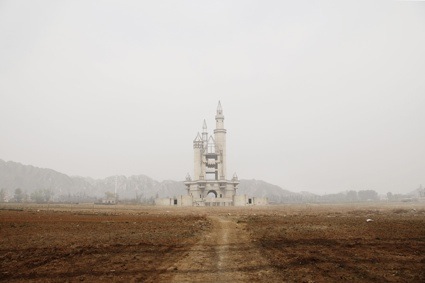 Catherine Hyland, Wonderland, China, C-Print, 1981.2 mm x 1280.8 mm
Catherine Hyland, Wonderland, China, C-Print, 1981.2 mm x 1280.8 mm
Last June, while i was confusedly walking up and down the stairs of the Graduate Exhibition of the Communication Art and Design department at RCA in London, i suddenly found myself gaping at three stunning, large scale photos by Catherine Hyland.
One of the photos is part of her Wonderland series which documents what remains of an amusement park conceived in 1998 to become the largest of its kind in Asia. Built near Beijing, the spectacular theme park was left to decay after funding was cut and agreement couldn’t be reached over the rights of the land. The other two photos were equally fascinating: one evoked the manufactured landscape of Edward Burtynsky, the other brought you to a much quieter yet somehow uncanny universe.
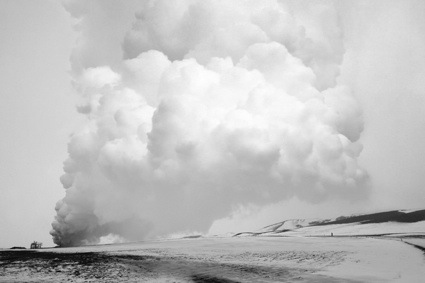 Inglenook, Iceland, 2011, C-Print, 1981.2 mm x 1119.77 mm
Inglenook, Iceland, 2011, C-Print, 1981.2 mm x 1119.77 mm
I had so many “why?” “how?” “where?” in my mind that i contacted Catherine and asked her if we could have a quick interview.
Hi Catherine! Could you describe the photos you were showing at the RCA show? What is the story behind them?
I was exhibiting three large format photographs as part of an ongoing body of work that aims to question the conventional view of the Sublime whilst critiquing the current state of our industrial landscape.
‘Wonderland’ shows the dilapidated skeleton of an abandoned theme park in China. Adopted by the local residents, it now exists as an unconventional playground within the town. To me it paints quite an intriguing picture of consumerism gone awry. The discarded structures of the half-built theme park have remained disconnected and vacant for over a decade. A spectacular contrast to the locals who continue to use ancient farming methods to tend the empty cornfields left surrounding it. At first glance you wouldn’t be blamed for thinking you had walked into some post-apocalyptic scene straight out of Cormac Mccarthy‘s The Road. There is a strange allure to what the locals are doing here, that creeps up on you in the most unsuspecting manner.
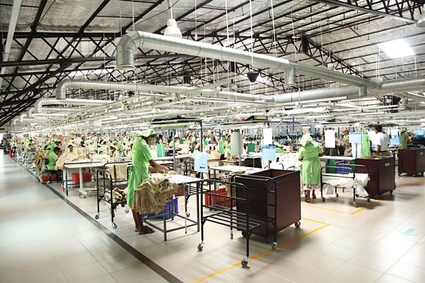 Catherine Hyland, The Finishing Room, Sri Lanka, 2010, C-print, 1981.2 mm x 1320.8 mm
Catherine Hyland, The Finishing Room, Sri Lanka, 2010, C-print, 1981.2 mm x 1320.8 mm
The second image titled ‘The Finishing Room’ was shot in Sri Lanka where I was attempting to chronicle the new types of Eco-Factories that are emerging in Southern Asia with increasing frequency. What I was inherently interested in was documenting – from the inside, our attempts to rectify a manufacturing system that has already spun out of control.
In contrast the third image ‘Inglenook’ shows the outcome of an industrial process. Made in response to the eruption of Eyjafjallajökull in April – May 2010, which caused enormous disruption to air travel across Western and Northern Europe, the piece hopes to create a seductively sinister husk of the former event. A poetic meditation of the prodigious but overlooked where the mirrored imagery of a natural event is echoed within our man-made environment.’
Catherine Hyland (image) and John Steele (sound), Inglenook
Where is Wonderland exactly? Your photos show a deserted place, is it already open to the public?
‘Wonderland’ itself is in China, just outside of Beijing. It was left over after funding was cut on another of their legion of newly developed tourist attractions. The project first began in 1998 but was left when developers and local farmers were unable to reach an agreement over the rights of the land. The fragments are now left for all to see and wander around at their will, like some monument to post-boom consumerism. The aim of the Wonderland developers was to create the biggest theme park in Asia. We are left looking at the cusp of an unrealised plan and as a result a far more interesting object, in my opinion.
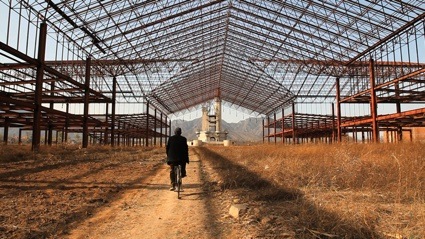 Wonderland I, China, 2011
Wonderland I, China, 2011
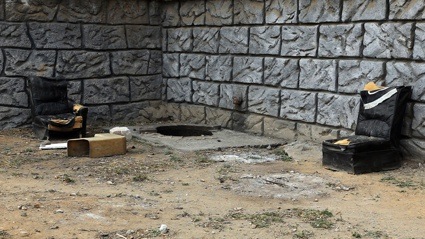 Wonderland VII, China, 2011
Wonderland VII, China, 2011
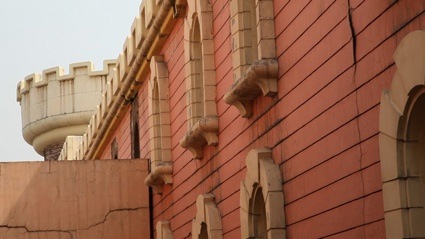 Wonderland XII, China, 2011
Wonderland XII, China, 2011
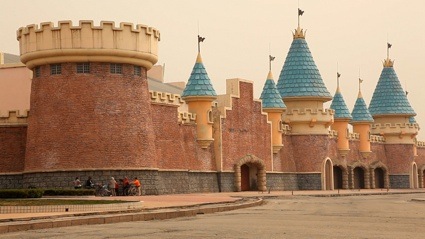 Wonderland VI, China, 2011
Wonderland VI, China, 2011
Catherine Hyland, Wonderland
I think that like most visitors of the RCA show i was fascinated by your images and intrigued by their location. How did you encounter these places? Was it by chance or did you hear or read about them somewhere?
I used to just drive/walk/cycle around for hours on end in search of something that intrigued me. As my practice has developed I’ve begun to research places more thoroughly, through the internet, sweeping through the National Geographic or just talking to people about their own experiences. There are so many channels of information out there for us to choose from that it seems to make sense to utilise and celebrate them. After all it’s usually the accidents that occur after the research that inform the final images anyway. Nothing compares to the more spontaneous aspect of it, stumbling into that moment that kind of stops you in your tracks. It’s a much more overwhelming and special experience that way.
But as my projects have become more complex the necessity for organisation and negotiation has become imperative. Many of the locations I choose exist as functioning places of work, often remaining shielded from public view. Sub-stations, quarries and power stations often exist down narrow lanes and engulfing woods, rendering the quest for them idiosyncratic in nature which is makes them even more enticing, like hidden worlds just waiting for the layers to be peeled back.
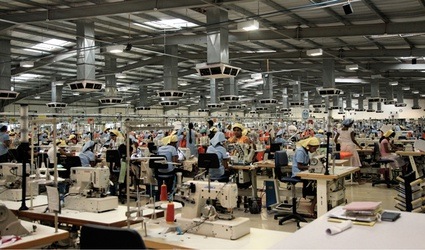 Catherine Hyland, Untitled III, Sri Lanka, 2010, C-print, 1981.2 mm x 1166.28 mm
Catherine Hyland, Untitled III, Sri Lanka, 2010, C-print, 1981.2 mm x 1166.28 mm
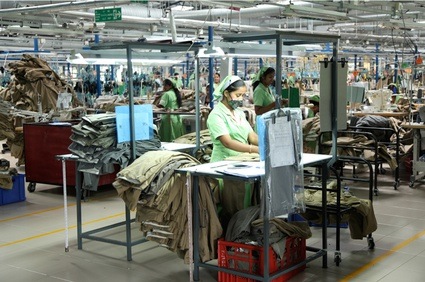 Catherine Hyland, Inspection Room, Sri Lanka, 2010, C-print, 1981.2 mm x 1320.8 mm
Catherine Hyland, Inspection Room, Sri Lanka, 2010, C-print, 1981.2 mm x 1320.8 mm
And was it easy to get access to them? I’m thinking about Wonderland of course but also about the factory in Sri Lanka.
With Wonderland my only obstacle was the language barrier, I found myself copying Chinese characters off the internet, a lengthy process to say the least. Passing my unpolished scraps of paper to bus drivers/taxis/general passers-by in the hope that my instructions might make sense. To this day I have no idea what my writing must have looked like or exactly what it said. I imagine it perhaps looked like a very handy 3 year old had written it for me. It was then just a process of faith, hoping that I was heading in the right direction. This to be honest it what made it fun. The Sri Lankan Eco-Factories were much easier to get access to, as I was actually filming a short documentary for the Sri Lanka Design Festival at the time in which we got shepherded about from one place to another to experience the apparel industry firsthand – it was an incredible trip.
It looks like you are already an accomplished photographer so why did you chose to enroll in a Master in Communication Art and Design? What did you hope to gain there?
I had the best two years of my life at the RCA, I chose Communication because it seemed to afford its students the kind of freedom I was after within a course that adopts a complete mixed bag of people in terms of disciplines. I thought that was fantastic, I look around the friends I have gained from studying in this way and realise just how beneficial that can be. Specific genres or mediums become increasingly less important and as a result the emphasis is placed almost wholey on the development of ideas that then come into fruition in completely unexpected, wild and wonderful ways. I think being in that environment is a really precious experience. Although it did make me realise personally just how firmly my feet were planted within the realm of lens based work, something which I’m happy to admit.
What are your plans after graduations? Are you flying to new ‘absurd’ locations?
I hope so, there is a project I desperately want to do in Japan, I just need to find a way of getting out there.
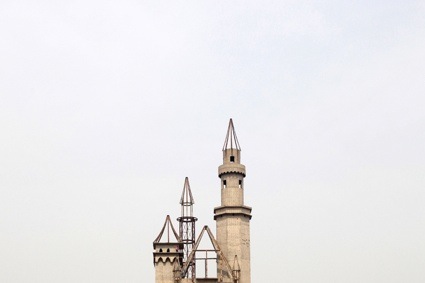 Wonderland XIII, China, 2011
Wonderland XIII, China, 2011
Thanks Catherine!
